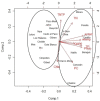First Report on Microcystin-LR Occurrence in Water Reservoirs of Eastern Cuba, and Environmental Trigger Factors
- PMID: 35324706
- PMCID: PMC8952431
- DOI: 10.3390/toxins14030209
First Report on Microcystin-LR Occurrence in Water Reservoirs of Eastern Cuba, and Environmental Trigger Factors
Abstract
The factors related to cyanotoxin occurrence and its social impact, with comprehension and risk perception being the most important issues, are not yet completely understood in the Cuban context. The objectives of this research were to determine the risk extension and microcystin-LR levels, and to identify the environmental factors that trigger the toxic cyanobacteria growth and microcystin-LR occurrence in 24 water reservoirs in eastern Cuba. Samplings were performed in the early morning hours, with in situ determination and physicochemical analysis carried out in the laboratory. Microcystin-LR were determined in water and within the cells (intracellular toxins) using UPLC-MS analysis after solid phase extraction. The reservoirs studied were found to be affected by eutrophication, with high levels of TN:TP ratio and phytoplankton cell concentrations, high water temperatures and low transparency, which cause collateral effect such as cyanobacterial bloom and microcystin-LR occurrence. In Hatillo, Chalóns, Parada, Mícara, Baraguá, Cautillo, La Yaya, Guisa and Jaibo reservoirs, concentrations of MC-LR higher than the WHO limits for drinking water (1 µg·L-1), were detected.
Keywords: TN:TP; UPLC–MS; cyanobacteria; microcystin-LR; water reservoir.
Conflict of interest statement
The authors declare no conflict of interest.
Figures






References
-
- Teta R., Romano V., Della Sala G., Picchio S., De Sterlich C., Mangoni A., Di Tullio G., Costantino V., Lega M. Cyanobacteria as indicators of water quality in Campania coasts, Italy: A monitoring strategy combining remote/proximal sensing and in situ data. Environ. Res. Lett. 2017;12:024001. doi: 10.1088/1748-9326/aa5649. - DOI
-
- Raffoul M., Enanga E., Senar O., Creed I., Trick C. Assessing the potential health risk of cyanobacteria and cyanotoxins in Lake Naivasha, Kenya. Hydrobiologia. 2020;847:1041–1056. doi: 10.1007/s10750-019-04167-z. - DOI
Publication types
MeSH terms
Substances
LinkOut - more resources
Full Text Sources
Medical

